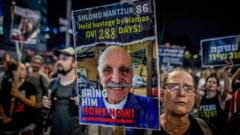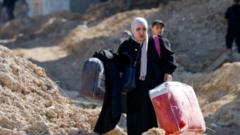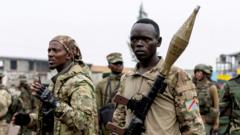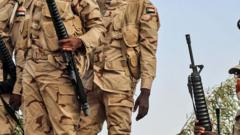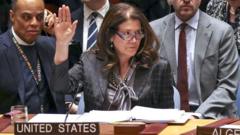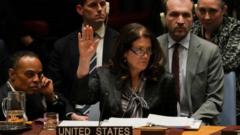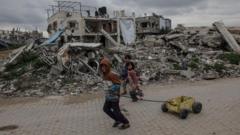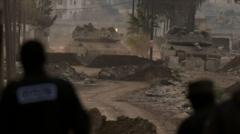The recent decision by Israeli troops to remain in southern Lebanon despite a truce deadline has sparked controversy and criticism from Lebanese authorities, highlighting ongoing tension in the region.
Israeli Forces Extend Presence in Southern Lebanon Amid Controversy
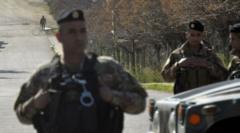
Israeli Forces Extend Presence in Southern Lebanon Amid Controversy
Israel's extended military presence in southern Lebanon raises questions over ceasefire compliance.
Villagers are cautiously returning to their homes in southern Lebanon as Israeli troops withdraw from several towns and villages; nonetheless, their continued presence at five strategic hilltops remains contentious. The Lebanese government has labeled this a breach of the ceasefire agreement that was brokered by the US and France, established after a period of intense conflict with Hezbollah.
The stipulated deadline for Israeli withdrawal was set for Tuesday, coinciding with the implementation of a truce that sought to remove Hezbollah forces from the south of Lebanon, allowing for the deployment of the Lebanese military in those areas. However, in an announcement made the previous day, Israeli military officials insisted that they would retain their positions until the Lebanese army fully executed its responsibilities under the accord, leaving many questions about the remaining timeline of their presence.
In the aftermath of the decision, Lebanese officials have stated that they view the ongoing Israeli military presence as an occupation. They reiterated the need for Israel to withdraw entirely, declaring that any remaining Israeli forces on Lebanese soil would not be accepted.
Early Tuesday morning, Lebanese soldiers moved in to reclaim areas previously held by Israeli forces, initiating efforts to clear roadblocks and search for unexploded ordnance. Residents returning to their communities were met with scenes of destruction. In Kfar Kila, near the border with Israel, many buildings bore the scars of battle. Twenty-five-year-old Safaa Jouma recounted her loss, saying, "Our house is destroyed just like all the other houses; we couldn't save anything."
Under the ceasefire agreement, Israel was instructed to pull out of southern Lebanon, while Lebanese authorities were tasked with ensuring that all armed groups were replaced by the Lebanese military south of the Litani River, situated about 20 miles north of Israel. Although an initial withdrawal deadline in January was postponed, tensions continued to mount as both sides grapple with their responsibilities and implications of the agreement.
In a statement, Israeli Foreign Minister Gideon Saar justified the military's presence as essential for security, emphasizing that operations against Hezbollah would remain vigorous, particularly in light of recent escalations including the unexpected Hamas attacks on October 7.
The conflict has taken a heavy toll on both sides, with estimates revealing over 3,960 casualties, predominantly among civilians in Lebanon, and substantial displacements. While many displaced from Lebanon have returned, reports suggest that a significant number of those in Israel remain unable to do so.
With an uncertain future, the region remains on edge as the delicate balance between sovereignty, security, and peace continues to be tested.
The stipulated deadline for Israeli withdrawal was set for Tuesday, coinciding with the implementation of a truce that sought to remove Hezbollah forces from the south of Lebanon, allowing for the deployment of the Lebanese military in those areas. However, in an announcement made the previous day, Israeli military officials insisted that they would retain their positions until the Lebanese army fully executed its responsibilities under the accord, leaving many questions about the remaining timeline of their presence.
In the aftermath of the decision, Lebanese officials have stated that they view the ongoing Israeli military presence as an occupation. They reiterated the need for Israel to withdraw entirely, declaring that any remaining Israeli forces on Lebanese soil would not be accepted.
Early Tuesday morning, Lebanese soldiers moved in to reclaim areas previously held by Israeli forces, initiating efforts to clear roadblocks and search for unexploded ordnance. Residents returning to their communities were met with scenes of destruction. In Kfar Kila, near the border with Israel, many buildings bore the scars of battle. Twenty-five-year-old Safaa Jouma recounted her loss, saying, "Our house is destroyed just like all the other houses; we couldn't save anything."
Under the ceasefire agreement, Israel was instructed to pull out of southern Lebanon, while Lebanese authorities were tasked with ensuring that all armed groups were replaced by the Lebanese military south of the Litani River, situated about 20 miles north of Israel. Although an initial withdrawal deadline in January was postponed, tensions continued to mount as both sides grapple with their responsibilities and implications of the agreement.
In a statement, Israeli Foreign Minister Gideon Saar justified the military's presence as essential for security, emphasizing that operations against Hezbollah would remain vigorous, particularly in light of recent escalations including the unexpected Hamas attacks on October 7.
The conflict has taken a heavy toll on both sides, with estimates revealing over 3,960 casualties, predominantly among civilians in Lebanon, and substantial displacements. While many displaced from Lebanon have returned, reports suggest that a significant number of those in Israel remain unable to do so.
With an uncertain future, the region remains on edge as the delicate balance between sovereignty, security, and peace continues to be tested.




